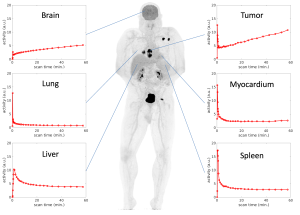Parametric imaging using dynamic PET and tracer kinetic modeling has traditionally been limited to single organs like the brain or heart due to the restricted axial field of view of conventional PET scanners (15-30 cm). However, whole-body PET kinetic quantification is essential to study metastatic cancer, organ crosstalk in systemic diseases, or systemic response to therapy. Our team at UC Davis has significantly contributed to whole-body PET parametric imaging through the development of direct reconstruction algorithms using optimization transfer and new kinetic modeling methods that are simplified for clinical use. Our Nested EM algorithm (Wang & Qi 2010) and Relative Patlak Plot (Zuo et al 2018) have been integrated into commercial PET scanners for whole-body parametric imaging by major manufacturers. Nonetheless, whole-body parametric imaging with conventional scanners still has a relatively low temporal resolution while covering the whole-body axial range, mainly limiting to macro-parametric imaging.
 The advent of total-body PET scanners such as the EXPLORER offers ultrahigh sensitivity and simultaneous coverage of the entire body for dynamic imaging. Our lab explores the potential of total-body dynamic PET for both macro-parametric imaging and micro-parametric imaging (Wang GB et al 2020; Wang Y et al 2021). We are developing methods to address technical challenges, such as optimizing the use of image-derived input function through voxelwise time-delay correction and model selection (Wang GB et al 2022) and pushing a higher compartmental resolution using high-frame-rate imaging (Wang Y et al 2024). We have also conducted clinical translation studies that demonstrate the advantages of total-body multi-parametric PET in studying COVID-19 (Wang Y et al 2023), cancer (Wang GB et al 2022, Wang Y et al 2024), and fatty liver disease.
The advent of total-body PET scanners such as the EXPLORER offers ultrahigh sensitivity and simultaneous coverage of the entire body for dynamic imaging. Our lab explores the potential of total-body dynamic PET for both macro-parametric imaging and micro-parametric imaging (Wang GB et al 2020; Wang Y et al 2021). We are developing methods to address technical challenges, such as optimizing the use of image-derived input function through voxelwise time-delay correction and model selection (Wang GB et al 2022) and pushing a higher compartmental resolution using high-frame-rate imaging (Wang Y et al 2024). We have also conducted clinical translation studies that demonstrate the advantages of total-body multi-parametric PET in studying COVID-19 (Wang Y et al 2023), cancer (Wang GB et al 2022, Wang Y et al 2024), and fatty liver disease.
Selected Papers and Materials on this topic:
- Li S, Abdelhafez YG, Nardo L, Cherry SR, Badawi RD, Wang GB.
Total-body parametric imaging using relative Patlak plot.
Journal of Nuclear Medicine, 66(4): 654–661, 2025. - Wang Y, Abdelhafez YG, Spencer BA, Verma R, Parikh M, Stollenwerk N, Nardo L, Jones T, Badawi RD, Cherry SR, and Wang GB.
High-Temporal Resolution Kinetic Modeling of Lung Tumors with Dual-Blood Input Function Using Total-Body Dynamic PET.
Journal of Nuclear Medicine, 65 (5) 714-721, 2024. - Li EJ, López JE, Spencer BA, Abdelhafez YA, Badawi RD, Wang GB, and Cherry SR.
Total-Body Perfusion Imaging with [11C]-Butanol.
Journal of Nuclear Medicine, 64(11):1831-1838, 2023. - Wang Y, Nardo L, Spencer BA, Abdelhafez Y, Li EJ, Omidvari N, Chaudhari AJ, Badawi RD, Jones T, Cherry SR, and Wang GB.
Total-Body Multiparametric PET Quantification of 18F-FDG Delivery and Metabolism in the Study of COVID-19 Recovery.
Journal of Nuclear Medicine, , 2023. - Wang Y, Spencer BA, Schmall J, Li E, Badawi RD, Jones T, Cherry SR, Wang GB.
High-temporal resolution lung kinetic modeling using total-body dynamic PET with time delay and dispersion corrections.
Journal of Nuclear Medicine, 2023. - Wang GB, Nardo L, Parikh M, Abdelhafez YG, Li E, Spencer BA, Qi J, Jones T, Cherry SR, Badawi RD.
Total-body PET multiparametric imaging of cancer using a voxel-wise strategy of compartmental modeling.
Journal of Nuclear Medicine, , 2022. - Wang Y, Li E, Cherry SR, Wang GB.
Total-body PET kinetic modeling and potential opportunities using deep learning.
PET Clinics, 16(4):613-625, 2021 - Wang GB.
Kinetic Modeling and Applications of Total-Body PET Technology.
Educational lecture at Total-Body PET 2021 Conference, Virtual Edinburgh, Scotland.